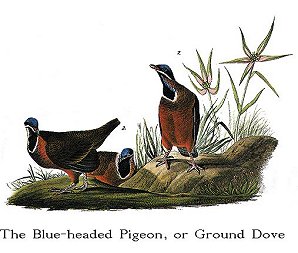
| Family XXIX. COLUMBINAE. PIGEONS. GENUS I. COLUMBA, Linn. DOVE. |
Next >> |

Family |
THE BLUE-HEADED PIGEON, OR GROUND DOVE. [Blue-headed Quail-Dove.] |
| Genus | STARNAENAS CYANOCEPHALA, Linn. [Starnoenas cyanocephala.] |
A few of these birds migrate each spring from the Island of Cuba to the
Keys of Florida, but are rarely seen, on account of the deep tangled woods in
which they live. Early in May 1832, while on a shooting excursion with the
commander of the United States Revenue Cutter Marion, I saw a pair of them on
the western side of Key West. They were near the water, picking gravel, but on
our approaching them they ran back into the thickets, which were only a few
yards distant. Several fishermen and wreckers informed us that they were more
abundant on the "Mule Keys;" but although a large party and myself searched
these islands for a whole day, not one did we discover there. I saw a pair
which I was told had been caught when young on the latter Keys, but I could not
obtain any other information respecting them, than that they were fed on cracked
corn and rice, which answered the purpose well.
I have represented three of these Pigeons on the ground, with some of the
creeping plants which grew in the place where I saw the pair mentioned above.
COLUMBA CYANOCEPHALA, Linn. Syst. Nat., vol. i. p. 282.
BLUE-HEADED PIGEON, Columba cyanocephala, Aud. Orn. Biog., vol. ii. p. 411.
Male, 12 1/4, 17 1/2.
Accidental on the southernmost Florida Keys in summer only.
Adult Male.
Bill straight, and short, rather slender, compressed; upper mandible with a
tumid fleshy covering at the base, a convex declinate obtuse tip, of which the
margins are acute and overlapping; lower mandible with the angle near the
extremity, which is compressed and rounded. Nostrils medial, oblique, linear.
Head small and compressed; the general form robust, resembling that of many
Partridges. Legs short and of moderate length; tarsus covered anteriorly and
laterally with quincuncial sub-hexagonal scales, rounded and scaly behind; toes
scutellate, free, margined; claws rather small, arched, compressed, flat
beneath, obtuse.
Plumage compact all over. Wings short, rounded, third, fourth and fifth
quills longest and almost equal; second, third, fourth, fifth and sixth slightly
cut out on the outer web. Tail of moderate length, slightly rounded, of twelve
broad rounded feathers.
Bill bright blue above, the fleshy parts at the base bright carmine. Iris
very dark brown. Scales of the feet carmine, the interspaces white; claws
bluish-grey. The general colour of the plumage above is a rich deep chocolate,
slightly tinged with olive, beneath brownish-red, lighter on the middle of the
breast, the sides and under tail coverts approaching to the tint of the back.
The upper part of the head bright blue, encircled by a band of deep black,
broader on the occiput, and very narrow in front; a band of white under the eye
meeting its fellow on the chin, a broad patch of black on the fore-neck,
margined with white beneath, and on the sides spotted with bright blue.
Length 12 1/4 inches, extent of wings 17 1/2; bill along the ridge 1/2,
along the edge 1; tarsus 1 1/4, middle toe 1 1/4; weight 10 1/4 oz.
The beautiful Cypress represented in this plate is quite abundant on all
the dry Keys of the Floridas, and is also found in many parts of the interior of
the peninsula.
| Next >> |